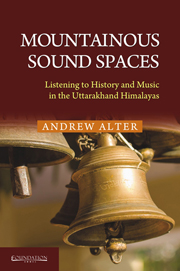Book contents
- Frontmatter
- Contents
- List of Figures
- List of Tables and Musical Examples
- Preface
- Acknowledgements
- Introduction
- 1 Echoes of Colonialism: Bagpipes in the Himalayas
- 2 Echoes of a Royal Heritage: Vestiges of Naubat
- 3 Possession and Performance: Sounding Out the Epic Worlds of Heroes and Gods
- 4 Worlds of Sound: Revisiting the Parameters of Oral Tradition
- 5 Flutes, Sprites and Mountainous Geographies
- 6 Drum Strokes, Syllables and Rhythmic Patterns
- 7 The Significance of Tantric Sects for Drum Practice in the Central Himalayas
- 8 Playing History: Sounding Out the Epic Worlds of Heroes and Gods
- 9 The Legacy of Garhwali Cassettes: Remembering the Pre-digital Age of Music Commodification
- Epilogue: Listening to an Uttarakhandi Himalayan Space
- Bibliography
- Index
Epilogue: Listening to an Uttarakhandi Himalayan Space
Published online by Cambridge University Press: 05 October 2014
- Frontmatter
- Contents
- List of Figures
- List of Tables and Musical Examples
- Preface
- Acknowledgements
- Introduction
- 1 Echoes of Colonialism: Bagpipes in the Himalayas
- 2 Echoes of a Royal Heritage: Vestiges of Naubat
- 3 Possession and Performance: Sounding Out the Epic Worlds of Heroes and Gods
- 4 Worlds of Sound: Revisiting the Parameters of Oral Tradition
- 5 Flutes, Sprites and Mountainous Geographies
- 6 Drum Strokes, Syllables and Rhythmic Patterns
- 7 The Significance of Tantric Sects for Drum Practice in the Central Himalayas
- 8 Playing History: Sounding Out the Epic Worlds of Heroes and Gods
- 9 The Legacy of Garhwali Cassettes: Remembering the Pre-digital Age of Music Commodification
- Epilogue: Listening to an Uttarakhandi Himalayan Space
- Bibliography
- Index
Summary
When I first listened to Kulanand Juyal's cassette, Gaṙhwālī Jāgar (Rama 140, 1988), I concentrated on its sounds. It wasn't the sort of cassette I would play as background music – it doesn't suit that situation – or at least not for me. Without paying much attention to it, I listened to it as I had habitually done with other cassettes. I listened to the words. I concentrated on trying to follow the story of Bāṇāsur as best I could and this was not easy, given my modest linguistic skills. I found my mind wandering to the drumming, and I began comparing it to what I was familiar with from other performances. The drum dropped out for periods and these absences were longer than I was used to. The bhauṇ pitches at the end of each line were more stable than I expected – quite unlike those of Dilwar Singh with whose style I was making a comparison. I was trying to identify technicalities within the sounds of its original performance; somehow trying to imagine the world of its original recording as well as what I unconsciously assumed to be conventional for the location of this kind of performance. Habitually, I was creating an imagined world constructed from my past experiences – experiences of listening to jāgars and cassettes. Without thinking, I had moved into an imagined space, assuming myself to be somehow next to the performers – not in a specific location, but in a generic Garhwali space within my ‘mind's eye’.
- Type
- Chapter
- Information
- Mountainous Sound SpacesListening to History and Music in the Uttarakhand Himalayas, pp. 151 - 162Publisher: Foundation BooksPrint publication year: 2014



